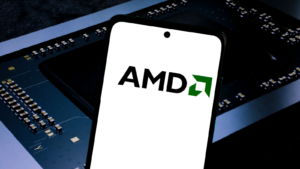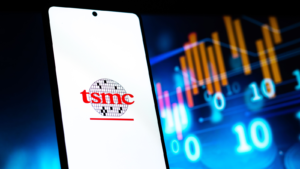Software, processors, and semiconductors are the key themes for promising stocks poised to reach trillion-dollar valuations by 2030. This article delves into the crux of their strategies, encapsulating pivotal facets that steer their trajectories. Discover what makes these stocks promising opportunities.
Broadcom (AVGO)

Broadcom’s (NASDAQ:AVGO) infrastructure software segment showcases steady growth. For example, in Q4 fiscal 2023, revenue reached $9.3 billion, marking a 4% year-on-year increase. This segment comprises significant acquisitions like CA, Symantec Enterprise, and Brocade, showcasing Broadcom’s strategic expansion in software solutions.
Additionally, renewal rates average 116% over expiring contracts in fiscal 2023, and the projection of 4% year-on-year revenue growth to $8 billion in fiscal 2024 indicates stable performance. Moreover, the VMware acquisition’s expected contribution is $12 billion in fiscal 2024, demonstrating Broadcom’s strategic pivot towards private and hybrid cloud solutions.
Fundamentally, the decision to divest non-core assets like end-user computing and Carbon Black reflects Broadcom’s focus on streamlining its software portfolio. By repositioning VMware and emphasizing a richer catalog of microservices tools for global enterprises, Broadcom aims to drive substantial revenue growth within the infrastructure software segment.
At the bottom line, Broadcom focuses on commendable financial efficiency, maintaining strong operating margins, and generating substantial free cash flow. There is a projected operating margin of 62% of revenue in Q4 fiscal 2023 and the expected adjusted EBITDA of approximately 60% in fiscal 2024. This highlights the company’s solid operational efficiency and profitability.
Regarding its liquidity, there is robust free cash flow growth to $17.6 billion in fiscal 2023, representing 49% of revenue. Hence, this indicates the company’s ability to convert a significant portion of its revenue into free cash flow.
Finally, Broadcom’s guidance for fiscal 2024 anticipates significant revenue growth, targeting $50 billion in consolidated revenues. Also, there is projected mid- to high-single-digit growth in semiconductor revenue. Lastly, an expected revenue of $20 billion in the infrastructure software segment, including a substantial contribution from VMware, implies the company’s ambitious yet achievable growth targets.
AMD (AMD)

AMD’s (NASDAQ:AMD) client segment displayed significant growth trends in revenue, marking a notable increase of 42% year-over-year and 46% sequentially. The impressive growth was primarily fueled by robust sales of Ryzen mobile processors and Ryzen 7000 Series processors for notebooks and desktops. This surge in demand highlights the segment’s success in capturing consumer interest and gaining market share.
Beyond the consumer market, AMD’s lead extended to the commercial sector. The company has reported expanded revenue driven by multiple new wins across various industries. The launch of Threadripper Pro workstation CPUs leverages the Zen 4 core architecture and targets professional design, rendering, and simulation applications. At its core, this strategic move aimed to tap into the high-performance computing needs of professionals across diverse fields. Therefore, this suggests AMD’s focus on addressing specific market niches with specialized offerings.
AMD’s forward-looking approach in the client segment emphasizes a multi-year roadmap centered on Ryzen AI. The focus is delivering leadership compute capabilities built on Microsoft’s (NASDAQ:MSFT) Windows software ecosystem to enable the next generation of AI PCs. This represents AMD’s edge through advancements in AI-driven computing. The intent to redefine the computing experience over the coming years signals a visionary perspective for aligning product development with evolving technological paradigms.
Looking forward, AMD’s outlook for Q4 2023 predicts revenue to reach approximately $6.1 billion. This is based on an expected increase of approximately 9% year-over-year and 5% sequentially. Therefore, the outlook is based on strong double-digit percentage growth in the data center and client segments, reflecting continued momentum in these areas.
Overall, the Client segment’s robust revenue growth, successful forays into commercial markets, and future-oriented innovation strategies position AMD favorably to capitalize on consumer and professional computing demands, setting a trajectory for sustained growth and market leadership.
TSMC (TSM)

TSMC (NYSE:TSM) relentlessly pursues advancing nanometer technologies. These include 3-nanometer (N3), N3E, N3P, and N3X, demonstrating its continual efforts to push the boundaries of semiconductor manufacturing. Also, the successful development and ramp-up of N3 technology and its variants reflect TSMC’s focus on delivering cutting-edge solutions to its customers.
Focusing on N2 technology, TSMC strategically focuses on developing N2 technology, leveraging nanosheet transistor structures for increased power efficiency. This signifies its forward-looking approach to addressing the increasing demand for energy-efficient computing solutions. Also, the innovation and advancement in N2 technology demonstrates the company’s focus on long-term technological leadership.
Fundamentally, the continuous enhancement and development of semiconductor technologies, such as N3 and N2, exemplifies TSMC’s focus on providing sustainable solutions for the semiconductor industry. Hence, these innovations cater to current market demands and solidify the way for future breakthroughs.
At its core, there is a strategic allocation of capital. It is 70% for advanced process technologies, 20% for specialty technologies, and 10% for advanced packaging, testing, mask-making, and other crucial areas. Thus, this demonstrates the company’s focus on enhancing its technological capabilities and readiness to address evolving market demands.
Finally, TSMC’s strategic expansion initiatives across different regions reinforce its focus on meeting customer needs, expanding its global presence, and leveraging government support for sustained growth. The company’s plans to establish factories in Europe (Dresden, Germany), Arizona, Japan, and China highlight its global expansion strategy. Overall, these initiatives are aligned with customer needs, tap into regional markets, and leverage government partnerships to bolster its manufacturing capabilities.
As of this writing, Yiannis Zourmpanos held a long position in TSM. The opinions expressed in this article are those of the writer, subject to the InvestorPlace.com Publishing Guidelines.
